
Bảo Đại, born Nguyễn Phúc/Phước Vĩnh Thụy, was the 13th and final emperor of the Nguyễn dynasty, the last ruling dynasty of Vietnam. From 1926 to 1945, he was emperor of Annam and de jure monarch of Tonkin, which were then protectorates in French Indochina, covering the present-day central and northern Vietnam. Bảo Đại ascended the throne in 1932.
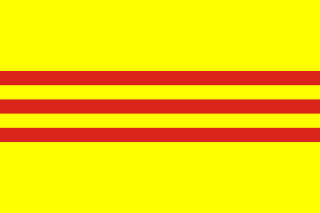
The State of Vietnam was a governmental entity in Southeast Asia that existed from 1949 until 1955, first as a member of the French Union and later as a country. The state claimed authority over all of Vietnam during the First Indochina War, although large parts of its territory were controlled by the Democratic Republic of Vietnam.
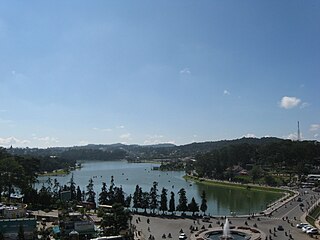
Da Lat or Dalat, is the capital of Lâm Đồng Province and the largest city of the Central Highlands region in Vietnam. The city is located 1,500 m (4,900 ft) above sea level on the Langbian Plateau. Da Lat is one of the most popular tourist destinations in Vietnam.
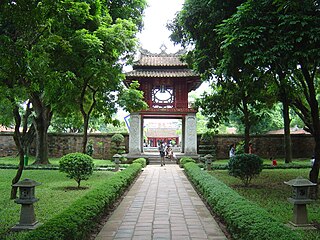
Văn Miếu, literally translated as Temple of Literature, is a temple dedicated to Confucius in Hanoi, northern Vietnam. The temple was built in 1070 at the time of Emperor Lý Thánh Tông, and it hosted the Imperial Academy, Vietnam's first national university, from 1076 to 1779.

Prince Nguyễn Phúc Bửu Lộc,, was an uncle of Emperor Bảo Đại, and Prime Minister of the State of Vietnam in 1954. He was a great-great-grandson of Emperor Minh Mạng, the second emperor of the Nguyễn dynasty. Both of his great-grandfather Nguyễn Phúc Miên Trinh and grandfather Nguyễn Phúc Hường Thiết were distinguished poets during the reign of Nguyễn dynasty. He later emigrated to Paris and spent his life there until his death in 1990.
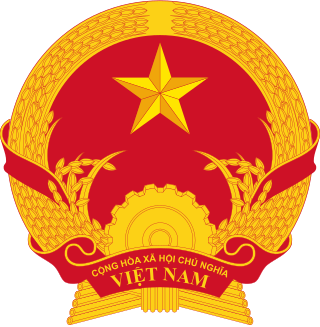
The emblem of Vietnam, formally the National emblem of the Socialist Republic of Vietnam, is one of the official national symbols representing the state of Socialist Republic of Vietnam. It is designed circular, having a red background and a yellow star in the middle which represent the five main classes in Vietnamese society—intellectuals, farmers, workers, business people and military personnel; the revolutionary history and bright future of Vietnam. The cog and crops represent the cooperation of agriculture and industrial labor.

The 1955 State of Vietnam referendum determined the future form of government of the State of Vietnam, the nation that was to become the Republic of Vietnam. It was contested by Prime Minister Ngô Đình Diệm, who proposed a republic, and former emperor Bảo Đại, who had abdicated in 1945 and at the time of the referendum held the title of head of state.
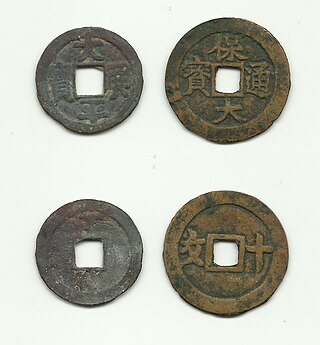
The Vietnamese cash, also called the sapek or sapèque, is a cast round coin with a square hole that was an official currency of Vietnam from the Đinh dynasty in 970 until the Nguyễn dynasty in 1945, and remained in circulation in North Vietnam until 1948. The same type of currency circulated in China, Japan, Korea, and Ryūkyū for centuries. Though the majority of Vietnamese cash coins throughout history were copper coins, lead, iron and zinc coins also circulated alongside them often at fluctuating rates. Coins made from metals of lower intrinsic value were introduced because of various superstitions involving Vietnamese people burying cash coins, as the problem of people burying cash coins became too much for the government. Almost all coins issued by government mints tended to be buried mere months after they had entered circulation. The Vietnamese government began issuing coins made from an alloy of zinc, lead, and tin. As these cash coins tended to be very fragile, they would decompose faster if buried, which caused the Vietnamese people to stop burying their coins.
Đinh Xuân Quảng was a Vietnamese judge and a politician who helped institute a new constitution for South Vietnam. Đinh Xuân Quảng was one of the main advocates of the “Nationalist solution” in the efforts to regain independence from France after World War II – an independence which could ultimately be settled through negotiations and peaceful means. He participated throughout this resolution process and negotiated various agreements with France. His efforts led to the abrogation of the Patenotre Treaty in 1884 which had placed Vietnam under a protectorate of France.
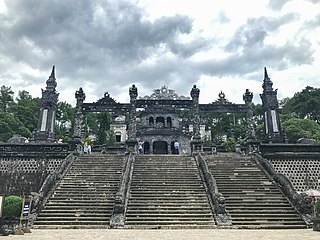
The Tomb of Khải Định, officially Ứng Mausoleum is a tomb built for Khải Định, the twelfth Emperor of the Nguyễn dynasty of Vietnam. It features a blend of Vietnamese architecture with Western styles. The tomb was completed in 1931 after 11 years of construction. It is located on Châu Chữ mountain near the former capital city of Huế. The tomb became a UNESCO World Heritage Site in 1993 as part of the Complex of Hué Monuments.

The House of Nguyễn Phúc, also known as the House of Nguyễn Phước, was a ruling family of Vietnam. It ruled from the city of Huế in central Vietnam beginning in 1636. As the Nguyễn lords, they often fought with the Trịnh lords, who were based in Hanoi. They were overthrown by the Tây Sơn dynasty in 1776.

Landmark 81 is a supertall skyscraper in Ho Chi Minh City, Vietnam. It is primarily invested and developed by Vinhomes, the largest Vietnamese real-estate developer. Landmark 81 holds the position of the tallest building in Vietnam, the second tallest building in Southeast Asia, as well as the seventeenth tallest building in the world overall.

Atatürk Museum Mansion is a historic house museum in Ankara, Turkey. It was the residence of President Mustafa Kemal Atatürk between 1921 and 1932, during the early years of the Republic. The museum is situated on Çankaya St. within the Çankaya Campus. It is situated right beside the Çankaya Mansion.

The Khải Định Thông Bảo was a French Indochinese sapèque coin produced from 1921 until 1933, the design of the coin was round with a square hole that was used for stringing them together. Khải Định became Emperor of Annam in 1916 the funding for the production of new cash coins was reduced by the Hanoi Mint which lead to the demand of the Vietnamese market for low value denominations to not be met, furthermore, after Hanoi reduced funding for the Thanh Hóa Mint, which until that time was producing enough low denomination cast cash coins to meet the market's demands, which caused most, but not all, of the production of cash coins at the mint to cease in 1920. In response a new committee was formed in Hanoi which ordered the creation of machine-struck Khải Định Thông Bảo cash coins, these are the first machine-struck four character Thông Bảo (通寳) coins in Vietnam with the reigning emperor's name as the French government had prior tried to introduce a Cochinchinese 2 sapèque coin that continued under French Indochina that weighed 2.05 grams and had a nominal value of 1⁄500 piastre, later the colonial government of the French Protectorate of Tonkin had unsuccessfully tried to introduce a zinc milled sapèque produced by the Paris Mint with a nominal value of 1⁄600 piastre from 1905 until 1906. Unlike the earlier attempts at producing machine-struck cash coins by the colonial French authorities the Khải Định Thông Bảo proved to be much more successful as the first series had a production of 27,629,000 coins while the second series greatly exceeded this with around 200,000,000 coins produced in Huế, Haiphong, and Hanoi. The Khải Định Thông Bảo continued to be produced long after the death of Emperor Khải Định under his successor Bảo Đại until it was phased out by the Bảo Đại Thông Bảo (保大通寳) in 1933.

The Thái Bình Hưng Bảo was the first cash coin produced in Vietnam as well as the oldest currency ever natively produced there. Despite bearing the actual legend of Đại Bình Hưng Bảo (大平興寶) it is known as the "Thái Bình Hưng Bảo" because the era name was "Thái Bình" (太平) as it was first minted in 970 under the reign of Ðinh Tiên Hoàng of the Đinh dynasty, its production ran until 979 under his son, Đinh Phế Đế. The Thái Bình Hưng Bảo was the only coin produced under the Đinh dynasty as even after Ðinh Tiên Hoàng was replaced by his son Đinh Phế Đế, coins the same inscription were continued to be manufactured. The Thái Bình Hưng Bảo helped assert Vietnam's economic, political, diplomatic, and cultural independence from China as up until that point imported Chinese cash coins were the de facto currency of Vietnam for areas that were high in trade. The introduction of a native currency was seen as being culturally significant as it asserted a national consciousness and a continued spirit of independence.

The Saigon Governor's Palace, also known as the Norodom Palace and then renamed Independence Palace, was a government building in Saigon, French Cochinchina, built between 1868 and 1873.
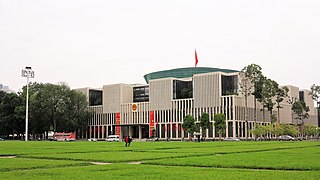
The National Assembly Building of Vietnam, officially the National Assembly House and also known as the New Ba Đình Hall, is a public building located on Ba Đình Square across from the Ho Chi Minh Mausoleum in Hanoi, Vietnam. Construction started on October 12, 2009, and finished on October 20, 2014. The building is used by the National Assembly of Vietnam for its sessions and other official functions.

The seals of the Nguyễn dynasty can refer to a collection of seals specifically made for the emperors of the Nguyễn dynasty, who reigned over Vietnam between the years 1802 and 1945, or to seals produced during this period in Vietnamese history in general.

The Domain of the Crown was originally the Nguyễn dynasty's geopolitical concept for its protectorates and principalities where the ethnic Kinh did not make up the majority, later it became a type of administrative unit of the State of Vietnam. It was officially established on 15 April 1950. In the areas of the Domain of the Crown, the Chief of State Bảo Đại was still officially titled as the "Emperor of the Nguyễn dynasty".

Kien Trung Palace is a palace within the Imperial City of Huế, the former imperial capital of Vietnam. It was the residence of the last two emperors of the Nguyễn dynasty. It was destroyed by the Viet Minh in 1947 during the Indochina Wars. Reconstruction started in 2019 and was completed in 2023. The palace is now open to the public.

















